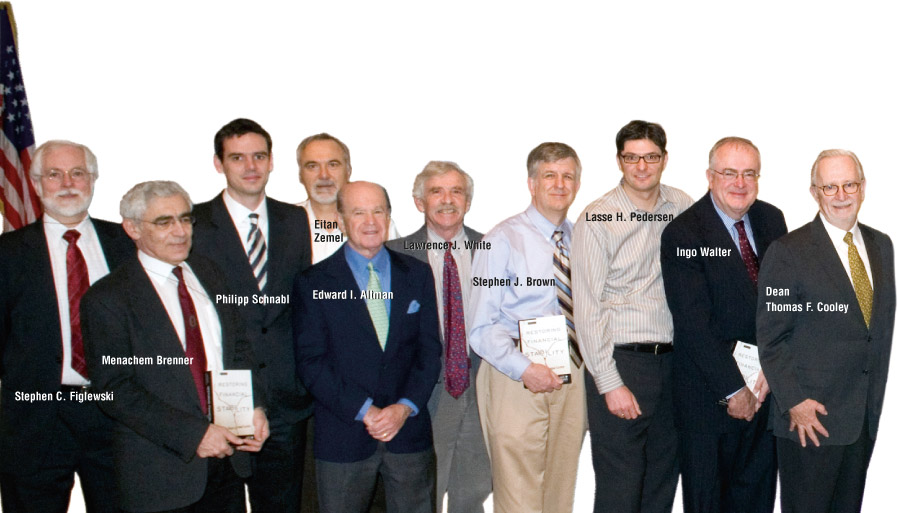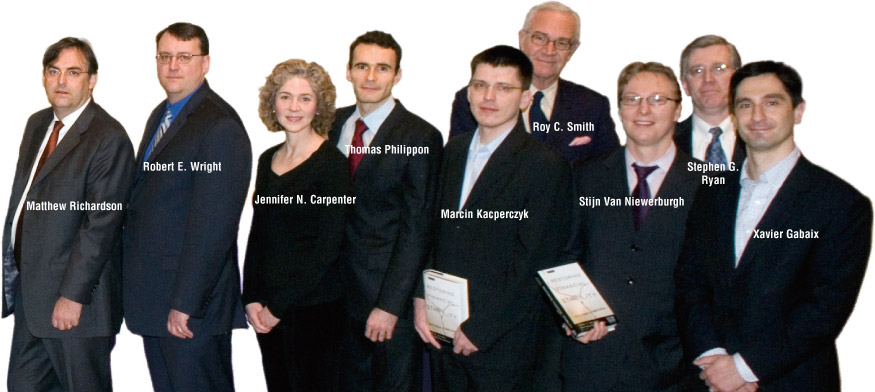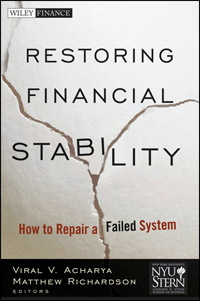


Authors not pictured: Viral V. Acharya, David K. Backus, Andrew Caplin, Gian Luca Clementi, Robert F. Engle, Dwight Jaffee, Kose John, Alexander Ljungqvist,
Anthony W. Lynch, Nouriel Roubini, Anthony Saunders, Marti G. Subrahmanyam, Rangarajan K. Sundaram, and Paul A. Wachtel
 What does “thought leadership” look like? Last October, as the crisis in the world financial system continued to unfold, it became clear that NYU Stern faculty were playing an important role in shaping the dialogue. Nothing had torn apart the market with such destructive force since the 1930s, and the conventional wisdom about how things are supposed to work in a well-functioning system was being challenged. Macroeconomist Dean Thomas F. Cooley and Vice Dean of Faculty and finance professor Ingo Walter decided that the financial disaster provided a unique opportunity to harness the School’s collective expertise and make a serious contribution to the repair efforts that were sure to get underway before long. As Stern is widely recognized as having one of the finest finance and economics faculties in the world, they knew Stern professors had plenty of ideas about what had gone wrong and what policies needed to be put in place.
What does “thought leadership” look like? Last October, as the crisis in the world financial system continued to unfold, it became clear that NYU Stern faculty were playing an important role in shaping the dialogue. Nothing had torn apart the market with such destructive force since the 1930s, and the conventional wisdom about how things are supposed to work in a well-functioning system was being challenged. Macroeconomist Dean Thomas F. Cooley and Vice Dean of Faculty and finance professor Ingo Walter decided that the financial disaster provided a unique opportunity to harness the School’s collective expertise and make a serious contribution to the repair efforts that were sure to get underway before long. As Stern is widely recognized as having one of the finest finance and economics faculties in the world, they knew Stern professors had plenty of ideas about what had gone wrong and what policies needed to be put in place.
They prompted a small group of professors to initiate a project to create white papers on the crisis and invited all interested faculty to participate. Eighteen weeks later, a book, Restoring Financial Stability: How to Repair a Failed System, was published by John Wiley & Sons. The book features 18 white papers written by 33 Stern and NYU faculty members from several of the School’s departments. The discussion – in day-long seminars, water-cooler commentary, and seemingly 24-hour e-mail – was intense, engaging, and, indeed, inspiring.
The point of the activity was not, however, only to foster intellectual excitement within the School, as important as that is. It was to bring clear-eyed analysis of what had gone wrong together with unbiased and independent recommendations for how the world’s financial system could be righted both in the short- and medium-term. Each of the papers started by discussing the nature of the problem, where things went wrong and where they stood at the moment, what options were available to repair the immediate damage and prevent a recurrence at the least possible cost to financial efficiency and growth, and a proposed course of action for public policy and business conduct. By mid-December, pre-publication copies of executive summaries and essays were spiral-bound and distributed to policymakers, congressional leaders, regulators around the world, and members of then President-Elect Obama’s transition team.
Finance professors Matthew Richardson, the director of the NYU Stern Salomon Center, and Viral V. Acharya took the lead in this effort, pulling all-nighters, nagging, cajoling, editing, and keeping the project on course.
For Stern faculty, the opportunity to engage on pressing global issues with colleagues from several departments exemplified the intellectual culture of the Stern School.
But more than that, recommendations and suggestions from papers collected in the book, spun off into op-ed pieces, media coverage, and other materials, have had a material impact on the current discussion.
Four Key Elements
This effort required four things to ensure impact: objectivity, credibility, immediacy, and dissemination. Objectivity meant maintaining clear independence from financial institutions, policymakers, and advisers who helped produce the financial disaster in the first place, and who would soon try to influence the repair process in ways that would inevitably favor their own interests. Credibility meant that the project had to be based on a combination of solid research and institutional knowledge that the Stern faculty is fortunate to have in abundance. Immediacy was driven by the need to impact the financial system repair process in its early and formative stages, before positions among regulators and politicians began to harden. And dissemination meant that the key findings and their underlying rationale had to have immediate impact but also provide a robust and durable template that would last through the drawn-out policy debates to come. All four objectives were achieved, and at breakneck speed.
The [economic] crisis is the ultimate teachable moment, and Stern students have been able to benefit immediately from the scholarly work that has been in progress. |
The executive summaries were posted, day by day, on the Stern website and also on Roubini Global Economics (RGE) Monitor, where they received literally thousands of hits.
To ensure that these thought pieces would be available in libraries worldwide, versions of the executive summaries were published in a special issue of Financial Markets, Institutions & Instruments.
The crisis is the ultimate teachable moment, as Dean Cooley called it, and Stern students have been able to benefit immediately from the scholarly work that has been in progress.
A five-lecture MBA course based on the book’s contents and taught by a dozen of the faculty authors began in early February and was oversubscribed as soon as it was offered. And in March, the School held a conference around the white papers, with alumni and press invited to hear, among others, featured speakers Paul A. Volcker (Hon. ’83), chairman of the Economic Recovery Advisory Board and former chairman of the Federal Reserve; Myron Scholes, chairman of Platinum Grove Asset Management and winner of the 1997 Nobel Memorial Prize in economics; and Charles Plosser, CEO of the Federal Reserve Bank of Philadelphia (see page 25).
Volcker, Scholes, Stern Faculty, and Industry Experts Debate – Before Alumni and the Media – How to Repair the Financial System
In March, NYU Stern hosted a panel discussion for alumni and the media that tapped into the energy behind the creation of Restoring Financial Stability: How to Repair a Failed System, a landmark project for the School that was published in March by John Wiley & Sons. At the half-day conference, such distinguished panelists as Paul Volcker (Hon. ’83), chairman of the Economic Recovery Advisory Board and former chairman of the Federal Reserve; Myron Scholes, chairman of Platinum Grove Asset Management and winner of the 1997 Nobel Memorial Prize in Economics; Charles Plosser, CEO of the Federal Reserve Bank of Philadelphia; Eric Dinallo, superintendent of the New York State Insurance Department; Madelyn Antoncic (MPhil ’81, PhD ’83), managing director and senior advisor at Lehman Brothers; and John Gapper, associate editor and chief business commentator at the Financial Times, joined Stern finance professors Ingo Walter, Matthew Richardson, Viral V. Acharya, and Thomas Philippon to expand upon the subject to a rapt audience.
General themes developed during the discussions, which were organized around the topics of how to restore financial stability and the future role of government in the financial system. Panelists decried the emergence of hyper-complex financial institutions whose failure jeopardizes the health of the economy. Walter called them financial “Godzillas” – companies too big to fail and too complex to regulate.
A general consensus emerged regarding a need to restructure and regulate the industry, but exactly how generated diverse proposals. Volcker suggested a two-tiered financial system – in which regulated commercial banks would be separate from capital markets – that would operate relatively regulation-free but just self-destruct if they blew up, rather than endanger the commercial credit apparatus. Some panelists favored an “über-regulator,” while others preferred a system of graduated regulatory bars pegged to the degree of systemic risk posed by a particular sector. More information about the conference, including video clips, is available online at http://whitepapers.stern.nyu.edu/conference. |
|
Early Reactions
Even before publication, the book’s analyses and advice had begun to get traction among the nation’s thought leaders. The ideas filtered into the national debate, appearing in op-ed pieces, on financial news networks, and in legislators’ briefing books. On Inauguration Day, an ad in the Financial Times directed readers to the Stern website that contains executive summaries of the white papers (http://whitepapers.stern.nyu.edu). The “Stern on Finance” blog, maintained by Thomas Philippon, assistant professor of finance, helped galvanize the discussion. According to Volcker, “The Stern School faculty is making an important contribution to the needed debate about how to go about reforming our broken financial system.”
The book is structured as 18 independent policy papers that propose market-focused solutions to each problem within a common framework. The papers are grouped into seven sections: Causes of the Financial Crisis; Financial Institutions; Governance, Incentives, and Fair-Value Accounting; Derivatives, Short-Selling, and Transparency; The Role of the Fed; The Bailout; and International Coordination. Observed Henry Kaufman (BA ’48, PhD ’58), president of Henry Kaufman & Co. and chairman emeritus of the Stern Board of Overseers: “What makes this book especially valuable are its detailed evaluations and analyses covering many spectrums of the marketplace.”
Potential Unlocked
Restoring Financial Stability is Stern’s first foray into producing an independent, published collection of faculty work, one that employs research-driven critical solutions that are projected into the political and economic dialogue on a national level. Together with the seminars and conference, the project underscores the multidimensional nature of Stern’s intellectual vigor. It is tangible evidence of the School’s mission to place its students and faculty at the nexus of business and society. Said Dean Cooley: “We embed the issues into the classroom, create top-flight research centers that produce state-of-the-art knowledge about important topics, and then become the venue in which the expertise is translated for the public. We must be, and indeed we are, shaping the debate itself.”
A Tour de Force
Looking back, this is an important milestone at a critical point in history. “There are few, if any, major business schools that could have pulled together such a broad and incisive analysis in such a short time,” said Vice Dean Walter. The book addresses the right issues, at the right time, and in the right way. And it was all accomplished without significant financial resources by an extraordinary talent pool convinced that the effort was important. More good academic work will, of course, be done, and, many others will enter the competition of ideas. Some already have. But what has become known as the “NYU Stern Report” has already become a benchmark against which they will be judged. This is what thought leadership looks like.

From left to right: At the conference on the white papers in March, book co-editor Viral V. Acharya spoke about regulatory reform and
Paul Volcker and Myron Scholes participated in a panel discussion on how to restore financial stability; Vice Dean Ingo Walter, Dean Thomas F. Cooley,
book co-editor Matthew Richardson, and finance professor Stijn Van Nieuwerburgh were some of the faculty who taught the MBA course on the financial crisis.


![]()